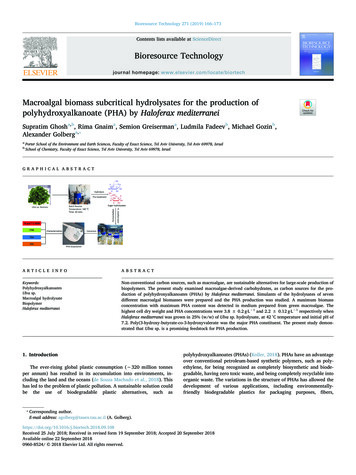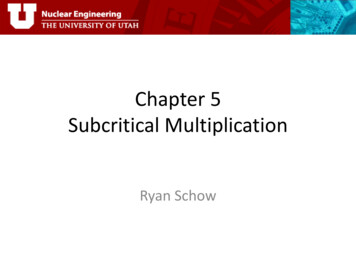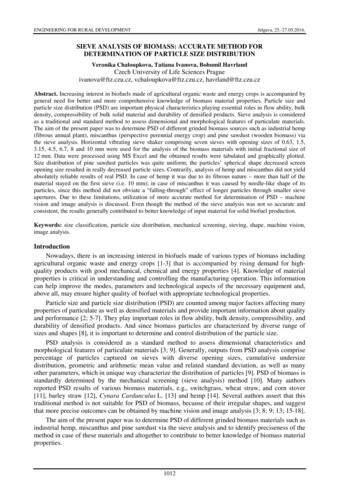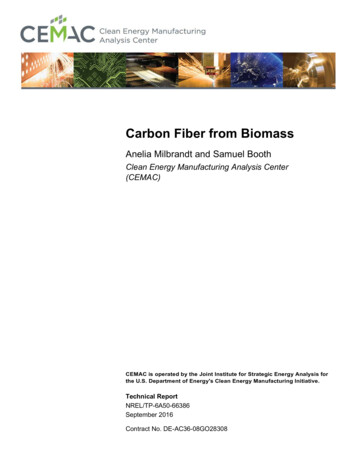
Transcription
Bioresource Technology 271 (2019) 166–173Contents lists available at ScienceDirectBioresource Technologyjournal homepage: www.elsevier.com/locate/biortechMacroalgal biomass subcritical hydrolysates for the production ofpolyhydroxyalkanoate (PHA) by Haloferax mediterraneiTSupratim Ghosha,b, Rima Gnaima, Semion Greisermana, Ludmila Fadeevb, Michael Gozinb,⁎Alexander Golberga,abPorter School of the Environment and Earth Sciences, Faculty of Exact Science, Tel Aviv University, Tel Aviv 69978, IsraelSchool of Chemistry, Faculty of Exact Science, Tel Aviv University, Tel Aviv 69978, IsraelG R A P H I C A L A B S T R A C TA R T I C LE I N FOA B S T R A C TKeywords:PolyhydroxyalkanoatesUlva sp.Macroalgal hydrolysateBiopolymerHaloferax mediterraneiNon-conventional carbon sources, such as macroalgae, are sustainable alternatives for large-scale production ofbiopolymers. The present study examined macroalgae-derived carbohydrates, as carbon sources for the production of polyhydroxyalkanoates (PHAs) by Haloferax mediterranei. Simulants of the hydrolysates of sevendifferent macroalgal biomasses were prepared and the PHA production was studied. A maximum biomassconcentration with maximum PHA content was detected in medium prepared from green macroalgae. Thehighest cell dry weight and PHA concentrations were 3.8 0.2 g·L 1 and 2.2 0.12 g·L 1 respectively whenHaloferax mediterranei was grown in 25% (w/w) of Ulva sp. hydrolysate, at 42 C temperature and initial pH of7.2. Poly(3-hydroxy-butyrate-co-3-hydroxyvalerate was the major PHA constituent. The present study demonstrated that Ulva sp. is a promising feedstock for PHA production.1. IntroductionThe ever-rising global plastic consumption ( 320 million tonnesper annum) has resulted in its accumulation into environments, including the land and the oceans (de Souza Machado et al., 2018). Thishas led to the problem of plastic pollution. A sustainable solution couldbe the use of biodegradable plastic alternatives, such as⁎polyhydroxyalkanoates (PHAs) (Koller, 2018). PHAs have an advantageover conventional petroleum-based synthetic polymers, such as polyethylene, for being recognized as completely biosynthetic and biodegradable, having zero toxic waste, and being completely recyclable intoorganic waste. The variations in the structure of PHAs has allowed thedevelopment of various applications, including environmentallyfriendly biodegradable plastics for packaging purposes, fibers,Corresponding author.E-mail address: agolberg@tauex.tau.ac.il (A. 9.108Received 25 July 2018; Received in revised form 19 September 2018; Accepted 20 September 2018Available online 22 September 20180960-8524/ 2018 Elsevier Ltd. All rights reserved.
Bioresource Technology 271 (2019) 166–173S. Ghosh et al.had the highest potential for PHA production. Therefore, Ulva sp. washydrolyzed using subcritical water (Parsa et al., 2018). The effect ofdifferent concentrations of the hydrolysate on PHA production with H.mediterranei was studied. The structural characteristics of the obtainedPHA were determined. The results could open a new venue for theproduction of bioplastics and bioenergy from the offshore grown biomass (Chemodanov et al., 2017a). This could, in turn, become a sustainable and environmentally friendly alternative to produce biopolymers in the long run.biocompatible implants, controlled drug-delivery devices and biofuels(Chen and Zhang, 2017; Zhang et al., 2009).The two most investigated types of PHAs are poly(3-hydroxybutyrate) (PHB) and . PHB is difficult to process into commodity goods, because it isstiff and brittle, has a high degree of crystallinity and its melting temperature (175 C) is close to its decomposition temperature (185 C)(Gahlawat and Soni, 2017). The introduction of 3-hydroxyvalerate(3HV) units, to form PHBV disrupts the highly crystalline PHB structure, resulting in a polymer with enhanced mechanical properties,quicker degradation rates, and improved physical properties (FerreGuell and Winterburn, 2018).The challenges for PHA production include dependence on purecarbon sources, such as glucose; the requirement of organic substitutesfor production of different types of PHA; the chances of contaminationand the use of large amounts of solvents in downstream processing(Rodriguez-Perez et al., 2018). Extreme halophiles could provide apartial solution to the problem of carbon sources, as they can utilizevarious inexpensive substrates for production of PHA (Yin et al., 2015).Among several extreme halophiles proposed for PHA production, Haloferax mediterranei has gathered considerable attention, since it oxyvalerate)(PHBV), without any supplementation of structurally-similar precursors, such as valerate (Bhattacharyya et al., 2012). Furthermore,high salinity requirements of H. mediterranei ( 15–25% salt water)decreases the chances of microbial contamination and thus reduces therequirement for media and equipment sterilization (Chen et al., 2017).Besides, the extraction of intracellular PHA does not require a highinput of chemical solvents as hypotonic environments that lead to celllysis (Moorkoth and Nampoothiri, 2016).Recent studies on PHA production using Haloferax mediterranei havefocused on utilization of inexpensive substrates. Starch (Chen et al.,2006), ethanol stillage (Bhattacharyya et al., 2014), vinnase(Bhattacharyya et al., 2012), molasses wastewater (Cui et al., 2017),olive mill wastewater (Alsafadi and Al-Mashaqbeh, 2017), and cheesewhey (Pais et al., 2016) are some examples of the proposed substrates.However, the availability of cheap substrates hinders the production ofPHA on a large scale (Koller et al., 2017). Therefore, new feedstocks arerequired to be explored to provide a sustainable solution for PHAproduction.Macroalgal biomass can be used as an alternative and suitablefeedstock for production of PHA. The various advantages of macroalgaeinclude that it does not require land for its cultivation (Fernand et al.,2017). The growth of macroalgae also needs very low nutrient supplementation. Macroalgae do not compete with conventional foodsources, thereby avoiding any conflicting applications of this feedstock(Jiang et al., 2016). Since macroalgae have a variety of carbohydratesdepending on species, information on their carbohydrate compositionsis necessary to utilize effectively as carbon sources for biomaterial andbioproducts (Chemodanov et al., 2017b; Ingle et al., 2018; Robin et al.,2017; Vitkin et al., 2015).Studies on PHA production using seaweed as a substrate have focused on brown seaweed (Azizi et al., 2017) or compounds extractedfrom seaweed (levulinic acid), which was supplemented to the medium(Bera et al., 2015). The red algae Gelidium amansii has also been used asa carbon substrate for PHA production (Alkotaini et al., 2016; Sawantet al., 2017). Notably, the utilization of green macroalgae, such as Ulvasp. for PHA production has not been explored yet. Ulva sp. blooms havebeen reported to cause eutrophication and the treatment of these bodieshave become a problem (Cui et al., 2018). PHA production using Ulvabiomass could provide a double benefit of waste remediation as well asthe production of value-added products.Our goal was to study the production of PHA from macroalgalbiomass hydrolysate using Haloferax mediterranei. First, the PHA production potential from 7 seaweed species was screened, using syntheticseaweed media. The composition of the green macroalgae from Ulva sp.2. Materials and methods2.1. Microorganism and culture conditionsThe microorganism used for the study was wild-type Haloferaxmediterranei. The culture was kindly provided by Prof. Uri Gophna ofFaculty of Life Sciences, Tel Aviv University. The H. mediterranei strainwere routinely grown in rich medium (Hv-YPC) containing (per L)144 g of NaCl, 21 g of MgSO4·7H2O, 18 g of MgCl2·6H2O, 4.2 g of KCl,and 12 mM Tris HCl (pH 7.5). For solid media, agar (Difco, USA) wasadded at a concentration of 15 g·L 1 and was dissolved by heating themedium in a microwave oven. Yeast extract (0.5% w/v; Difco, USA),0.1% (w/v) peptone (Oxoid) (Difco, USA), and 0.1% (w/v) CasaminoAcids (Difco, USA) was added and the medium was autoclaved. Aftercooling, CaCl2 was added to a final concentration of 3 mM (Allers et al.,2010). For the preparation of culture plates, 2% w/v of Agar powderwas added to the medium. The organism was grown at 42 C in atemperature-controlled incubator. For liquid cultures, the microorganism was grown in 250 mL Duran bottles with a working volume of100 mL. The culture was grown in a shaking incubator (MRC Labs, Israel) at 42 C with a rotational speed of 180 rpm. The media pH wasadjusted to 7.2.2.2. PHA production in the different cultivation medium2.2.1. PHA production by H. Mediterranei in Hv-YPC mediumThe PHA production was initially studied using the Hv-YPCmedium. The medium was supplemented with 2% (w/v) glucose tomaintain a higher C/N ratio. Higher C/N ratio has been reported for theenhanced production of PHA (Kucera et al., 2018). The PHA productionin various pure carbon substrates was also studied. The pure substrateswere supplemented to Hv-YPC medium for PHA production.2.2.2. PHA production by H. Mediterranei in simulated seaweedhydrolysate mediumPHA production of H. mediterranei was also studied in syntheticmedia where the carbon source was equivalent to the composition ofdifferent seaweed hydrolysates. The carbohydrate compositions of different seaweed hydrolysates of the eastern Mediterranean region werestudied by Robin et al. (2017). Hv-YPC media was modified by substituting with a similar carbon concentration of hydrolysates as suggested in earlier studies (Robin et al., 2017). The extracted PHA wasquantified and characterized.2.2.3. PHA production by H. Mediterranei using seaweed hydrolysateThe green macroalga Ulva sp. was grown in our laboratory undercontrolled conditions using cylindrical, sleeve-like macroalgae photobioreactors (MPBR) (Polytiv, Israel, Length 100 cm, thickness 200 mm,width 40 cm) (Chemodanov et al., 2017b) under natural irradiance inJuly 2017. Artificial seawater (ASW) having a total salinity of 3.7%,prepared using distilled water and dried Red Sea salt (Red Sea Inc, IS)was used as a cultivation medium. Nutrients were supplied by addingammonium nitrate (NH4NO3, Haifa Chemicals Ltd, IS) and phosphoricacid (H3PO4, Haifa Chemicals Ltd, IS) to maintain 6.4 g·m 3 of nitrogen(N2) and 0.97 g·m 3 of phosphorus (P) in the ASW. Initially, 20 g freshUlva sp. was inoculated in each sleeve with total volume of 40.4 L in a167
Bioresource Technology 271 (2019) 166–173S. Ghosh et al.The GC conditions were as follows: injection volume 0.2 μL (Agilentauto-sampler G4513A); injector temperature 280 C with split ratio of1:19; initial oven temperature 70 C hold for 5 min and increased to280 C at a rate of 15 C/min and followed by temperature rise to 320 Cat a rate of 30 C/min with 5 min hold time. MS was performed in the EIpositive ion mode, using the electron energy of 70 eV. Transfer linetemperature and ion source temperature were maintained at 280 and250 C, respectively. MS data were collected in full-scan mode (m/z50–400) and analyzed with Agilent Chemstation software.reactor. All other conditions such as pH, temperature and flow ratewere maintained as mentioned in our previous study (Chemodanovet al., 2017b). Ulva sp. hydrolysate was utilized for PHA productionusing Haloferax mediterranei. The hydrolysis was performed in a customized batch reactor (Zhengzhou Keda Machinery and InstrumentEquipment CJF-0.25, China) under a 180 C for 30 min (Thiruvenkadamet al., 2015). The solid load for the hydrolysis was 8% w/v Ulva sp.biomass. The sugar and 5-HMF content were monitored by HPAEC-PAD(High-Pressure Anion-Exchange Chromatography coupled with PulsedAmperometric Detection) using a Dionex ICS-5000 platform (Dionex,Thermo Fischer Scientific, MA, USA) with an analytical column (Aminopack 10) and its corresponding guard column. An electrochemicaldetector with an AgCl reference electrode was used for detection. Theanalysis was performed using an isocratic flow of 4.8 mM KOH generated by the Eluent Generator technology (Dionex, Thermo FischerScientific, MA, USA). Various concentrations of seaweed hydrolysate (0– 100% w/v) were used and the growth characteristics and PHA production were analyzed. Peptone was utilized as the nitrogen source inconcentrations as used in the Hv-YPC medium. Seawater was addedaccording to the concentrations used in the Hv-YPC medium.2.5. Determination of biomass and PHA yield2.5.1. Volumetric biomass and PHA productivityVolumetric biomass productivity (PBiomass, g·L 1·h 1) was calculated by the following equation.PBiomass X2 X1t2 t1(1) 1where X1 and X2 are biomass concentrations (g·L ) at time t1 (h) and t2(h) respectively.Volumetric PHA productivity (PPHA, g·L 1·h 1) was calculated bythe following equation.2.3. Extraction of PHAThe liquid culture (100 mL) was centrifuged at 2500 rpm for 15mins in a swing rotor centrifuge (Rotanta 420R, Hettich Instruments LP,USA). The obtained cell pellet was dried in a hot air oven at 60 Covernight. The dry weight of the pellet was determined. 15 mL ofacetone (Merck) was added to the dried pellet and was kept in a refrigerator overnight to remove the pigments. The suspension was centrifuged at 2500 rpm for 15 min and dried at 60 C to remove excessacetone. PHA was extracted with chloroform (Merck, USA) at 37 C for24 hrs under shaking conditions at 100 rpm (Balkrishna, 2015).PPHA P2 P1t2 t1where P1 and P2 are the amount of PHA accumulated (g·L(h) and t2 (h) respectively.(2) 1) at time t12.5.2. PHA yieldThe PHA yield was determined by a gravimetric method whereinthe extracted polymer was dried at 70 C till constant weight was obtained. The yield (%) was calculated as:2.4. Quantification of intrace
First, the PHA pro-duction potential from 7 seaweed species was screened, using synthetic seaweed media. The composition of the green macroalgae from Ulva sp. had the highest potential for PHA production. Therefore, Ulva sp. was hydrolyzed using subcritical water (Parsa et al., 2018). The effect of different concentrations of the hydrolysate on PHA production with H. mediterranei was











